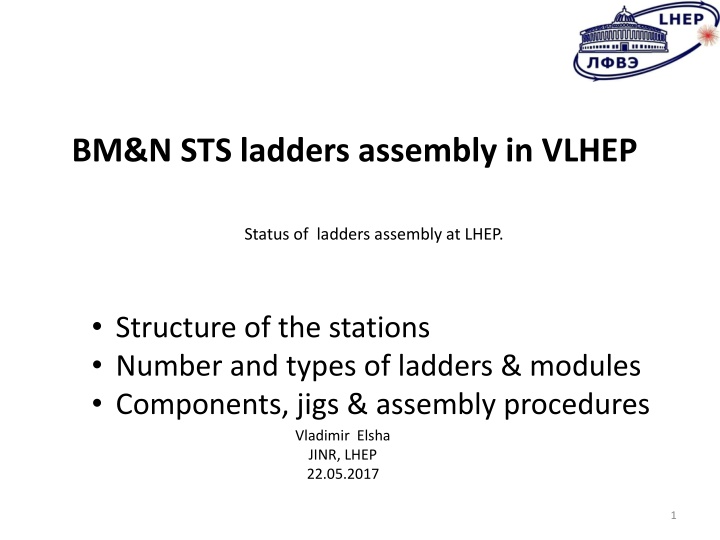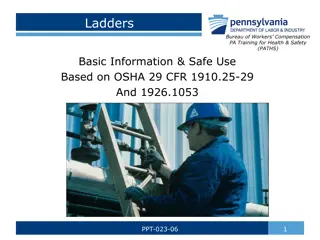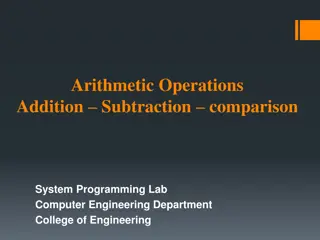BM&N.STS Ladders Assembly at VLHEP: Structure, Components, Procedures
This document outlines the status of ladders assembly at LHEP, including the structure of stations, number and types of ladders, modules, components, jigs, and assembly procedures. It provides details on the necessary components, sensors, ladders, and assembly devices for BM&N.STS stations based on Jochen Kunkel's paper. Images and diagrams offer visual insights into the ladders assembly process at VLHEP.
Download Presentation

Please find below an Image/Link to download the presentation.
The content on the website is provided AS IS for your information and personal use only. It may not be sold, licensed, or shared on other websites without obtaining consent from the author.If you encounter any issues during the download, it is possible that the publisher has removed the file from their server.
You are allowed to download the files provided on this website for personal or commercial use, subject to the condition that they are used lawfully. All files are the property of their respective owners.
The content on the website is provided AS IS for your information and personal use only. It may not be sold, licensed, or shared on other websites without obtaining consent from the author.
E N D
Presentation Transcript
BM&N STS ladders assembly in VLHEP Status of ladders assembly at LHEP. Structure of the stations Number and types of ladders & modules Components, jigs & assembly procedures Vladimir Elsha JINR, LHEP 22.05.2017 1
1. Supposed structure of the BM&N STS stations Supposed four BM&N STS stations Structure of stations based on Jochen Kunkel paper (1) Stations 1 and 2 are assumed like Station 0 by Kunkel Stations 3 and 4 are assumed like Station 1 Number of ladders may be reduced for stations 1,2,3 But Station 4 supposed like full size Station 1 by Kunkel Anyway number of modules and ladders necessary for two Station 0 and two Station 1 should be produced and assembled. which is Ladders which not included in the stations initially can be used as a spare. Station 0 (2 pc) Station 1 (2 pc) 2
2. Number and types of ladders & modules There are 3 pin to pin lengths of ladders which used in both types of Stations. These are 294.6 mm (294), 414.6 mm (414), 454.6 mm (454). Type 414 and 454 are the same for Station 0 and Station 1 , (except central ladders). Type 294 used in Station 1 only. The Station 0 consist of ladders 2x414 normal 4x454 normal 2x454 central 8 Ladders The Station 1 consist of ladders 2x294 normal 4x414 normal 4x454 normal 2x454 central 12 Ladders Total number of ladders should be produced is 40 for 2- Station 0 and 2- Station 1 Ladder type 294n consist of type 414n type 454n type 454c Sensors are necessary: 6x6-88 pc 4-6x6 2-6x6 4-6 6 modules 4-4x6 2-4 6 4-6 6 4x6-96 pc 4-2x6 4-2 6 2-4 6 2x6-112pc All ladders initially are without double 6x6 sensor modules. But type 294 ladders are possibly to do with double 6x6 sensor modules. 3
3. Available components We got a sufficient number of: HPC sensors S13847 62x62 with specification from producer CIS sensors CBM08 42x62 with specification from producer HPC sensors S13847 22x62 single metal without specification CF-ladders by Igolkin drawings (with smooth edges) and installation parts 4
4. Components that must be obtained STS-XYTER Chips FEBs Module cables kit 5
5. Assembly device Design and production of Ladder assembly device are in collaboration with Planar Minsk. As result of this work we hope to obtain device which suitable for assembling ladders with any pin to pin distances till 1 m and possibly wider. The main trouble is time limitation. 2 years is too long for us but Planar requires a 2 year for design and production. Device consist of 1. Base table 2. Optical system 3. XYZ coordinate system for optics 4. XY coordinate units for modules 5. CF-frame holder 6. CF-frame lift unit 7. Base for modules preliminary adjustment 8. Module carrying tool 9. Ladder removing tool 10. Storage containers 11. PC 12. Application program Points 1-4 will be ready in December 2017 6
Specification of the Assembly device The precision of the sensor orientation X coordinate Y coordinate 50 mkm 15 mkm on 1200 mm base 12 mkm on 180 mm base 50 mkm 2 mkm 1200 mm 22x62 mm; 42x62 mm; 62x62 mm 320 15 mkm 20 6 8 20 20 AC220V, 50Hz, 500Wt 1500 900 1400 mm 900 kg Z coordinate The precision of the recognition system Move the optical system X coordinate Sensors sizes The thickness of sensors A number of XY coordinate units for modules A number of vacuum clamps for sens. 22x62 mm 42x62 mm 62x62 mm Vacuum channels Power Dimensions Weight (no more) (no more) 7
Assembly device concept Optical alignment of alignment marks for each sensor through modules mounting Optical checking of sensors position before gluing Gluing of all modules L-legs to CF-frame in one process HPC alignment mark 8
6. Assembly procedure The preliminary operation before ladder assembly is L-Legs gluing. L-legs should be glued on longitudinal edges of the sensor (see picture below) L-legs Assembly starts from periphery to the center of the ladder. Each ladder may contain from 4 till 10 modules placed on 6 levels. Cables Interstrip cable (for 2x6 only) on p-side Following pictures shown ladder assembly procedure with 4 pair of modules 9
Step 1. Edge to edge adjustment of the module in preliminary position before assembling Module with single sensor 22x62 mm and interstrip cable for example Sensor fixed with vacuum clamp Cables and FEBs are on support freely.
Step 2. Mounting carrying tool on the base above module Carrying tool is fixed on base (with screws). Upper cable fixed on carrying tool (with vacuum)
Step 3. Cables & FEBs holder placed under them and fixed to carrying tool (with screws)
Module is ready to carrying to assembly position (after unfixing from base) Interstrip cable on p-side
Possibly to prepare a few modules for assembly (like variant)
Or even to prepare all modules of ladder For example
Step 4. Mounting vacuum clamps for sensors and Cable holders onto assembly position side view Each vacuum clamp equipped with independent XY adjustment screws and vacuum channel. (not shown) Height of working surface adjusted with 1 mm calibrated plates. (not shown)
Step 5. Carrying, mounting and adjustment 1stpair of modules start from periphery Double sensor module for example Sensor fixed with vacuum and adjusted with optical system and alignment marks. Sensors, cables, FEBs moving as one.
Removing of carrying tool and straighten cables in plan on cable holder for 1stpair Adjusted sensors fixed with vacuum. Cables and FEBs are on support freely
Step 6. Carrying, mounting and adjustment 2ndpair of modules The optical system should be driven by the PC program and give the position for each point of alignment.
Removing of carrying tool and straighten cables in plan on cable holder for 2nd pair The cables are stacked on cable holders
Step 7. Carrying, mounting and adjustment 3rdpair of modules The position of the each alignment mark may be illuminated by the laser on sensor surface, or to be shown as the cross on the video cam picture.
Removing of carrying tool and straighten cables in plan on cable holder for 3rd pair
Step 8. Carrying, mounting and adjustment modules of central part
Removing of carrying tool and straighten cables in plan on cable holder for modules of central part
Step 9. Mounting of the cable clamps Cable clamps Cables are held together
Step 10. Mounting of the CF-frame above modules Cable holders are removed
Step 11. Mounting CF-frame. Gluing L-legs and cable clamps to CF-frame in one process After check of positions of all alignment mark with optical system.
Step 13. Transfer of the cooling boxes in the operating position
Step 14. Joining CF-frame and cooling boxes with 1sthalf of storage container
Step 15. Removing of the complete ladder from device All clamps are released
Step 16. Mounting of the 2ndhalf of storage container Ladder ready to be stored
8.References 1. Jochen Kunkel Pin-to-Pin distances of CBM STS ladders, documentation and so on 2015-03-30 36
BM&N STS = 4 stations = 40 ladders of 3 types = 300 simple one sensor modules Thank you for your attention!























